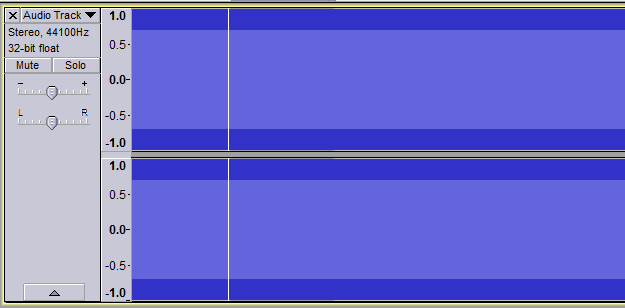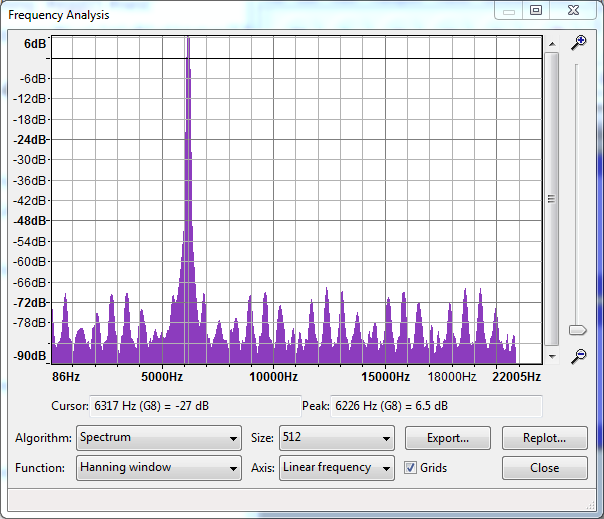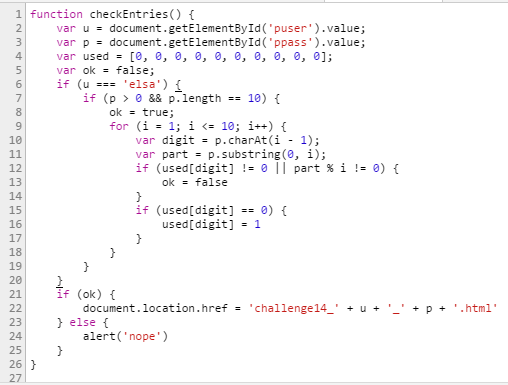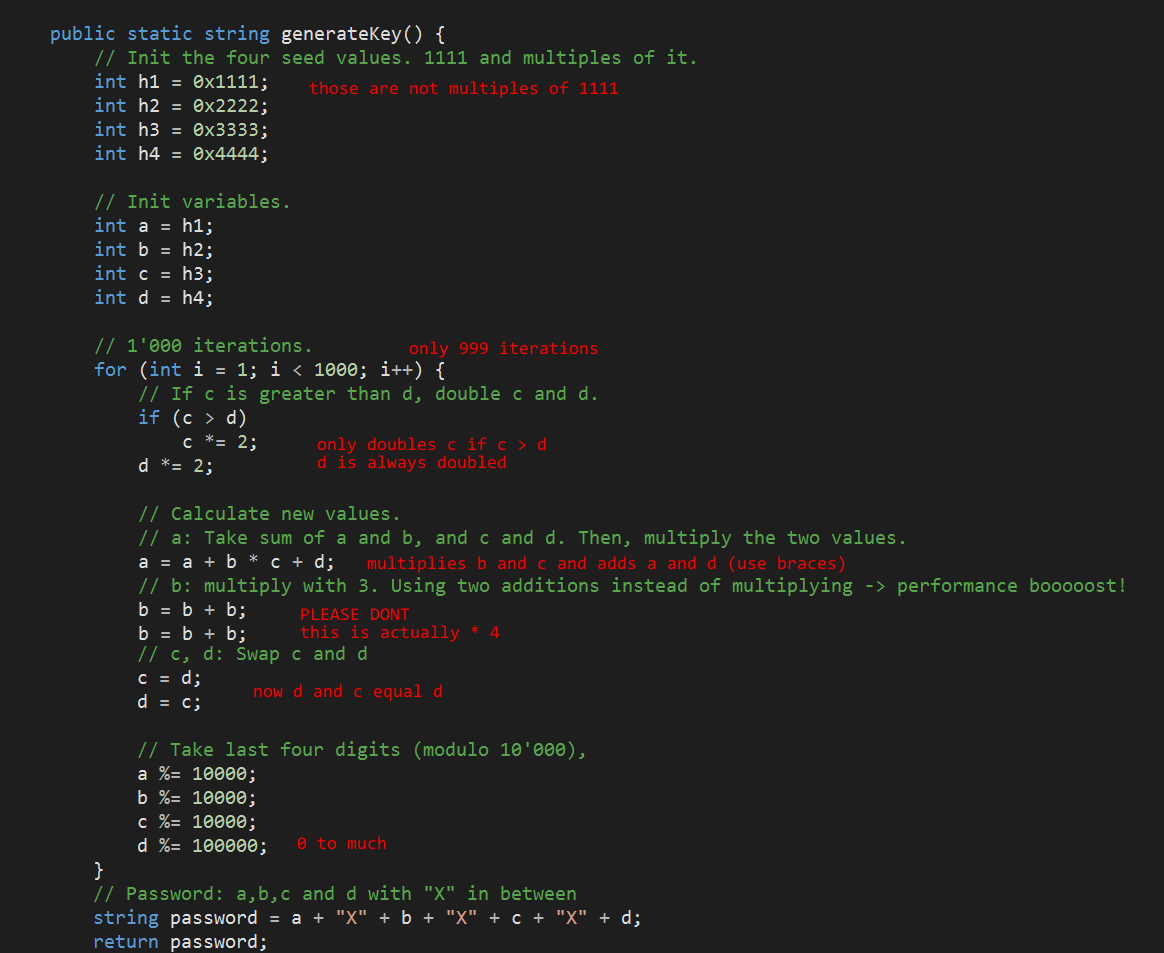This is a write-up of my solutions for the Hacky Easter 2016 white-hat free hacking competition for education and fun.
The official solution document, which contains two of mine solutions, can be found here.
Also keep in mind: These solutions may not be the fastest, most useful or most practical way of solving the given challenge and as always there is no guarantee that the code does not fry your computer and I am not to be held responsible for anything good or bad that happens to you and/or your computer because of my code snippets.
1 2 3 4 5 6 7 8 9 10 11 12 13 14 15 16 17 18 19 20 21 22 23 24
-
Remove all spaces, newlines and the baby emote from the given text and you get
xthexyhiddenyystringyyisyymollycoddlexysoxxsimpley -
Remove all unnecessary x's and y's and replace with space where appropriate
the hidden string is mollycoddle so simple
=> mollycoddle
Using the International maritime signal flags the promotion code enjoyafreshseabreeze was extracted (some flags did not exist and were left out).
The "little bird" phrase and the hashtag on the egg clues to twitter.
And after searching #egg03 #nest
=> https://twitter.com/8lueL1ttleB1rd/status/720201875945984001
I installed the Hacky Easter app on the Android emulator BlueStacks and set Audacity to record the WASAPI loopback (the audio coming from my pc).
The recording looks like this:
Marking the region with the “beep” and selecting Analyse => Plot Spectrum:
With the wanted frequency in the middle at 6200Hz. Do this 5 times and you got your egg!
The video does not contain any clues so one of the 4 subtitle languages should contain our password. Looking through the subtitle files which are just plain text you will find at the bottom of the Esperanto subtitles:
1
00:01:00.000 -=> 00:01:03.000
passphrase is "youtubelotitis"
Klick on each elevator button and it will redirect you to challenge06.html?floor={floornumber} except button 13 which will bring you to challenge06.html?sybbe=punatrzr.
sybbe is rot13 of floor and punatrzr is rot13 of changeme.
We expect floor thirteen so rot13 of thirteen is guvegrra.
Thus, we need to visit challenge06.html?sybbe=guvegrra and voila there is the egg.
"The solution is in the solutions! Go back and scroll to 123!" Probably referring to Hacky Easter 2015 Solutions or Hacky Easter 2014 Solutions and indeed on page 123 of the 2015 solutions:
password: goldfish
When changing your phone orientation the image either changes or goes back to the previous image. After a few minutes of trial and error this sequence will get you the egg. Put your phone initially in Portrait orientation and tilt the top in the specified direction (Do not tilt between steps):
left right right left left right right left right left left
The left picture represents an unplayed chess board where a 1 means a piece is present in this square and 0 the opposite.
When viewing each row as binary the rows produce the values in the red box e.g. 0b11111111 = 255 and 0b00000000 = 0.
The provided text consists of many moves in Algebraic notation.
Using the nodejs library node-chess this simple nodejs program was created.
var chess = require("chess");
var game = chess.create();
var moves = ["e4", "e5", "... all the other moves until", "Qf4+", "Rg3"]
moves.forEach(function (move) {
game.move(move);
});
var squares = game.getStatus().board.squares;
var row = "";
for (var i = 0; i < squares.length; i++) {
if (i % 8 == 0) { // next row
console.log(line);
row = "";
}
row += squares[i].piece ? "1" : "0";
}
console.log(row);The output is then interpreted to binary. This site helped me.
output decimal
00000000 0
10000011 131
01000011 67
00100100 36
10101000 168
01001100 76
00100001 33
00000001 1
So the result could be 0-131-67-36-168-76-33-1 or 1-33-76-168-36-67-131-0.
Test both and the second should get you the egg!
After analyzing the javascript code this formula was extracted and can be used to draw a pixel at (x, y) with the value v.
If the result is 1 the pixel is white if 0 blue. This is nothing other than a mathematical way of getting the bit at a specific position. Knowing this I wrote a simple python script to get the target plot:
from PIL import Image # pip install pillow
im = Image.open("plot.png") # from http://hackyeaster.hacking-lab.com/hackyeaster/images/plot.png
def get(x, y):
# each pixel is 4x4 in size
r, g, b = im.getpixel((4 * x, 4 * y))
return r + g + b == 255 * 3 # check if white
out = 0
for x in range(0, 106): # 106 width
for y in range(0, 17): # 17 height
bit = 1 if get(x, 16 - y) else 0
out = (out << 1) | bit # appends bit AFTER out
# Our image has (0, 0) in the top left.
# The javascript sees the first pixel in the top right.
# So normally we need to access the pixel by get(105 - x, y)
# but because our bits are in the opposite direction as
# they should be we flip the image horizontal and vertical
# thus we need to access the data with get(x, 16 - y)
print(out * 17)=> 17657949201581490152887262552977461550821547861463862839240664323911642807489754168164179332567124887458095049966838272395838833335464853226293169893063985683542234868393982863605544853380459104965350326137397441646486218169598347856207906783361422905911386919743769975974237367400302886153547602709155224361686573545769765610544442950623858438305126210029328322211845690185546981876389418111008050801364588449772605640341039292322155464883254208546726202316901388360683605114288184962864450110296056848249404578342545423849729556480
which indeed matches the target.
It seems like every ring has all but one char multiple times present. So I wrote this python script:
rings = [
"peoplle",
"kakosfflaohls",
"xjqsimpeljqninxmpel",
"idlyrvchefpdopoefussycrlhuv",
"cpidephjklonkamuffyiolyumsschajdett",
"buwxhappysdfbkcooltqwreezymklcfdtvqhvsmrzxu",
"beanstzkcdauueiyzybmvxgpjlcxnjqwoowqfdhilfrmgpsrtvk"
]
out = ""
for ring in reversed(rings):
nring = list(ring)
for char in ring:
if nring.count(char) > 1:
nring = [i for i in nring if i != char]
out += "".join(nring)
print(out)=> hanisho
The zip bomb must be decompressed then all git merges must be restored to get the next zip witch is then gonna be decompressed and so on.
I wrote this bash script to extract the zips until we meet one which needs a password:
#!/bin/bash
IFS='
'
shopt -s nullglob
if [ $# -gt 1 ]; then
echo "Usage: $0 [start (default 1000)]"
exit 1
fi
curr=${1:-"1000"}
if [ "$curr" -eq "1000" ]; then
unzip -q "$curr.zip" || { echo "unzip failed"; exit 1; }
fi
while [ -n "$curr" ]; do
echo $curr
next=
commits=$(git --git-dir=./$curr/.git --work-tree=./$curr log --pretty=%H) || exit 1;
for commit in $commits; do
git --git-dir=./$curr/.git --work-tree=./$curr checkout $commit . || { echo "checkout failed"; exit 1; }
for zip in $curr/*.zip; do
unzip -q -P "incorrect" "$zip" || { echo "done"; exit; }
# panic if password is wrong
# (we do this so it wont ask us and just fail)
filename=$(basename "$zip")
next="${filename%.*}" # without .zip
done
done
if [ "$curr" -ne "0001" ]; then
rm -fr $curr || exit 1;
fi
curr=$next
donerun it in the same directory as the 1000.zip
chmod +x extract
./extractThis will extract until 0045.zip which needs a password, that is in the name of one of the merges in the 0046 directory.
Pass is fluffy99
Extract the protected zip unzip -q -P fluffy99 0046/0045.zip and ./extract 0045 to let it finish extracting.
Folder 0001 should contain your egg.
The secret can't be in the first and second layer of the QR-codes because that would be too trivial for Hacky Easter so it must be in the third!
I wrote this small QR-code parser (unrelated to Hacky Easter): https://github.com/TheSiki24/qrparse
This simple script will parse all the small 21*21 QR-codes:
from qr import QR # https://github.com/TheSiki24/qrparse
from PIL import Image
im = Image.open("wallpaper.jpg")
width, height = im.size
for x in range(0, width // 21):
for y in range(0, height // 21):
qr_data = []
for ys in range(y * 21, y * 21 + 21):
row = ""
for xs in range(x * 21, x * 21 + 21):
r, g, b = im.getpixel((xs, ys))
row += "#" if r + g + b <= 60 else " "
qr_data.append(row)
if sum(row.count("#") for row in qr_data) < 28:
# no qr code because of to few black pixel
continue
try:
qr = QR(lambda x, y: qr_data[y][x] == "#")
print(qr.text)
except Exception, e:
print("error: " + str(x) + ", " + str(y))
After inspecting the output I noticed, that all 52750 parsed QR-codes start with xx except the one containing the password:
=> fractalsaresokewl
To not trip into traps or having to deobfuscate code just ask your browser what he executes: Inspect the form
Ask console what the function is and click on it.
Perfect source code:
=> user: elsa
I'm to lazy to use my brain to get the password... lets bruteforce:
import itertools
for val in itertools.imap("".join, itertools.permutations(map(str, range(10)))):
ok = True
for i in range(10):
part = int(val[0:i + 1])
if part % (i + 1) != 0:
ok = False
break
if ok:
print(val)
exit()=> pw: 3816547290
Mount image using mount command on linux or a mount tool on Windows.
wolf.jpg contains pig 2: Cassadee in the EXIF section "comments".
This website helped me (on windows just check the properties of the file).
story.txt contains unnecessary tabs and spaces between and after lines.
This is called "Whitespace steganography" and using the tool SNOW the string pig 1: Filbert was extracted.
Since song.mp3 did not contain any clues on the cipher used I had to guess. I found the program MP3stego which could successfully decode the mp3 and yield pig 3: Wynchell.
What I did not know was that when the decoder asks you for a passphrase you don't actually have to enter one. So, of course, I tried way too long to crack the password.
Using dex2jar and jdgui the app was decompiled which was not actually needed because the app is so kind and sends the hmac secret eggsited with every message.
The hmac used is just the color in hex with the key.
Using this hmac generator and selecting ffff00 (yellow in hex) as message and eggsited as key the hmac 1da02c68080863fa302c20c3312371f4e365a5f9 was generated.
Now you just need to GET http://hackyeaster.hacking-lab.com/hackyeaster/egg?code=ffff00&key=eggsited&hmac=1da02c68080863fa302c20c3312371f4e365a5f9.
The returned base64 encoded png file can be converted online here and after renaming the downloaded file your egg should present itself.
The language reminded me of the programming Language Logo.
The only missing commands were hop, egg and lineofeggs
After a lot of trial and error these are the functions I created:
to hop :i
forward :i
end
to backhop :cnt
left 180
hop :cnt
right 180
end
to egg
backhop 5
right 90
forward 5
left 90
filled 000000 [
forward 10
left 90
forward 10
left 90
forward 10
left 90
forward 10
left 90
]
hop 5
left 90
hop 5
right 90
fill
end
to lineofeggs :cnt
repeat :cnt [egg hop 10 ]
backhop 10
end
also
cs
penup
must be called before the supplied commands.
Using this online Logo Interpreter the turtle drew this:
fixed:
public static string generateKey() {
int a = 1 * 1111;
int b = 2 * 1111;
int c = 3 * 1111;
int d = 4 * 1111;
for (int i = 0; i < 1000; i++) {
if (c > d) {
c *= 2;
d *= 2;
}
a = (a + b) * (c + d);
b *= 3;
int tmp = c;
c = d;
d = tmp;
a %= 10000;
b %= 10000;
c %= 10000;
d %= 10000;
}
return a + "X" + b + "X" + c + "X" + d;
}After reversing the binary with ida I came up with this approximate c pseudo code:
#include "stdlib.h"
#include "stdio.h"
#include "stdint.h"
#include "string.h"
int main(int argc, const char** argv) {
char raw[18] = {
// the 17 values to find
, 0
};
char* input = raw;
if (strlen(input) <= 16)
goto fail;
int i = 0;
int c = *input++;
int v8 = 0;
int v9 = c;
int va = 0;
int vb = 0;
int vc = 0;
int vd = 0;
while (1) {
if ((i % 3) == 0)
vd += c;
if ((i & 0b11) == 2)
vc += c;
i++;
va = (uint8_t)(v9);
vb = (uint8_t)(v8);
vc = (uint8_t)(vc);
vd = (uint8_t)(vd);
if (i == 16)
break;
c = *input++;
v9 = va + c;
v8 = vb + c;
if (!(i & 1))
v8 = vb;
}
if (va == 133 && vb == 67 && vc == 176 && vd == 79)
printf("yuss %i %i %i %i\n", va, vb, vc, vd);
else
fail:
printf("nope %i %i %i %i\n", va, vb, vc, vd);
return 0;
}and after logging every operation this is the flow of the variables:
# charindex operation
0: vd += c
2: v8 = vb
2: vc += c
3: vd += c
4: v8 = vb
6: v8 = vb
6: vd += c
6: vc += c
8: v8 = vb
9: vd += c
10: v8 = vb
10: vc += c
12: v8 = vb
12: vd += c
14: v8 = vb
14: vc += c
15: vd += c
Which could be used to construct these terms: (numbers in sum are char index, numbers right of == are the real target numbers)
sum(1, 3, 5, 7, 9, 11, 13, 15) == 67
sum(0, 3, 6, 9, 12, 15) == 79
sum(2, 6, 10, 14) == 176
sum(0, 1, 2, 3, 4, 5, 6, 7, 8, 9, 10, 11, 12, 13, 14, 15) == 133
And after setting each char value to its initial value of 1 I could, with a bit of patience, solve this equation by hand.
These are one of the many possible values for the chars:
74, 60, 102, 1, -86, 1, 1, 1, -99, 1, 1, 1, 1, 1, 72, 1
or in hex 0x4a3c6601aa0101019d01010101014801
(make sure no 0x0a (\n) are included)
Sending this and newline to the server:
echo -ne "\x4a\x3c\x66\x01\xaa\x01\x01\x01\x9d\x01\x01\x01\x01\x01\x48\x01\n" | nc hackyeaster.hacking-lab.com 1234=> ida.lo\/es.you And I love you IDA :)
The 3 tables were restored from the mysql dump to a running mysql server.
After joining all three tables on userid and keeid those are the interesting fields:
blahb (blob), kee (key), puzz (pass) and sawlt (salt)
The procedures DeekryptKee, GetPuzzMishMash and KryptKee were provided by the dump.
Using the length and encoding of the input and output parameters of the procedures I guessed that this is what happened:
GetPuzzMishMashwas called with the user supplied password and the corresponding salt. The result was stored inpuzz.KryptKeewas called with the user supplied password and the key used for the aes encryption of the blob.- The blob was aes encrypted using
AES_ENCRYPT.
KryptKee is using 10000 nested sha1 so this function could not be reversed to get the user supplied password.
GetPuzzMishMash can be used because it is only one salted sha1 calculation:
sha1(salt + "." + pass + "." + salt)
Lets hit it with a password list (get the list here and name it pwlist.txt):
import hashlib
hashs = {
"de2278f5bcafcbb097ecc1fb54e5ab8a9e912c55": "efgh",
"943f9ecbbd91306a561d0e3c15e18ee700007083": "abcd",
"0cf32f8f418659f23f8968d4f63ea5c98b39f833": "zyxw",
"1742ae4507fc480958e2437104e677e70aa5e857": "jklm",
"915d253cb5ba6f0a220bca83e2d6d3258af15e68": "nmlk"
}
hashs = dict((k.decode("hex"), v) for k, v in hashs.iteritems())
with open("pwlist.txt", "rb") as file:
for line in file:
for target, salt in hashs.iteritems():
h = hashlib.sha1(salt + "." + line.strip() + "." + salt)
if h.digest() == target:
print(h.hexdigest() + " found " + line.strip())
del hashs[target]
break=> 0cf32f8f418659f23f8968d4f63ea5c98b39f833 found snakeoil
Knowing the password the key was decrypted:
call DeekryptKee('snakeoil', '1ABF4B7CD25C61FDF0E74EC2BFB43BD1C2D8ECD803AFA3AA376F4C0000052813', @out);
SELECT @out;=> jpP8HeoEC5OCCBqdf9N3
Finally decrypt the blob
SELECT AES_DECRYPT(blahb, 'jpP8HeoEC5OCCBqdf9N3') from fyle;And surprise, one turned out to be a png file :)
Just export and there is the egg.
Just do this 4 times and search for online decipher:
Caesar cipher: Use this website and select 'guess' as key.
=> AS A RULE MEN WORRY MORE ABOUT WHAT THEY CANT SEE THAN ABOUT WHAT THEY CAN PASSWORD IS CARTHAGO
Polybius cipher: Use this website.
=> there is no witness so dreadful no accuser so terrible as the conscience that dwells in the heart of every man peloponnese is the password
Vigenère cipher: Use this website and select the option without a key.
This results in almost correct messages with similar looking keys (parispanis and similar). What key could it possible be??? panispanis or parisparis
=> phrase you need is alchemy...
Playfair cipher: Using this project which needs to be compiled in linux the cipher was cracked (spaces were added manually):
=> THE PLAYFAIR CIPHER WAS THE FIRST PRACTICAL ... PASSWORD IS BLETCHLEY
The supplied code snippet was looking just like the source code of the sha1 hash function and indeed after looking through this implementation the only noticeable change I found were the initial state variables h0 - h4.
After modifying the code the hashes could be cracked using this password list.
Just use the changed implementation and feed it with every password... Just like Challenge 20
0: zombie
1: Denver1
2: Placebo
3: SHADOWLAND
When reading the pixel values of the image and test if they are even or odd this is the result:
Coincidence? I don't think so!
So obviously the data is encoded so that one bit is an even / odd pixel for each of the 3 channels. After trying for two months how these bits should be interpreted the simplest solution did not come to my mind: Just merge the 3 bit streams to one file. Why did I never try this :( ARGHHH
from PIL import Image
from bitarray import bitarray
im = Image.open("heizohack.bmp")
pixels = zip(
im.getdata(0), # r
im.getdata(1), # g
im.getdata(2) # b
)
stream = bitarray()
for pixel in pixels:
r, g, b = pixel
stream.append(r % 2 == 1)
stream.append(g % 2 == 1)
stream.append(b % 2 == 1)
with open("merged.png", "wb") as f:
stream.tofile(f)This will provide you with this png image:
The red bit is the data to extract and if r, g, b and a xor'd together are 1 the data is authentic and should be included in the output.
im = Image.open("merged.png")
pixels = zip(
im.getdata(0), # r
im.getdata(1), # g
im.getdata(2), # b
im.getdata(3) # a
)
def get_bit(val, offset):
mask = 1 << (7 - offset)
return val & mask
stream = bitarray()
for pixel in pixels:
for i in range(8):
r, g, b, a = map(lambda p: get_bit(p, i), pixel)
if r ^ g ^ b ^ a == 1: # authenticity test
stream.append(r != 0) # int to bool
print(stream.tobytes())=> lostinthewoooods
Using the provided source code we first need to generate a short url whose long url starts with http://evileaster.com and collides with the official short url IU66SMI:
import hashlib, base64, itertools, string
query = base64.b32decode("IU66SMI=")
prefix = "http://evileaster.com/"
i = 0
for l in range(1, 10):
for suffix in itertools.imap("".join, itertools.product(string.ascii_lowercase, repeat=l)):
url = prefix + suffix
if hashlib.sha256(url.encode("UTF-8")).digest()[0:4] == query:
print(url)
exit()
i += 1
if i % 1000000 == 0:
print(i, suffix)Note that pytohn is very slow and I recommend implementing a cracker in C++ using this sha246 source code which in my case did speed up the cracking a lot. Also, look into using ocl hashcat!
One possible url is http://evileaster.com/jghirfj
Next, we need to find the censored key. The key is 5 chars long (1 + length(key) * 3 == 16) and thus can be easily bruteforced:
First, we shorten a sample url eg. http://asdf and log the requests our browser does. The browser recieves the shorted url http://crunch.ly/TIBSPOQ and the ticket in base64.
Knowing this we can bruteforce the cryptTicket function to get the 5 char secret key.
import base64, string, itertools
from Crypto.Cipher import AES
full_url = "http://asdf"
short_url = "http://crunch.ly/TIBSPOQ"
plain = base64.b64encode(full_url) + "@" + base64.b64encode(short_url)
target = base64.b64decode("ykryhYxlXP/yUKSz4xyIPR9hrmIgq+TG8ty2vy/TP/XSDUNuSBkX16JGijd9f8QpK6DtL2sJDMLgnOf/zCw3qw==")
plain_block = plain[0:16]
target_block = target[0:16]
mask = string.ascii_lowercase + string.ascii_uppercase
i = 0
for key in itertools.imap("".join, itertools.product(mask, repeat=5)):
aes = AES.new("x" + key + key + key, AES.MODE_CBC, "hackyeasterisfun")
if aes.encrypt(plain_block) == target_block:
print(key)
exit()
i += 1
if i % 1000000 == 0:
print(i, key)This provides us with the key tKguF which we can use to craft our own token:
import base64
from Crypto.Cipher import AES
full_url = "http://evileaster.com/jghirfj"
short_url = "http://crunch.ly/IU66SMI"
plain = base64.b64encode(full_url) + "@" + base64.b64encode(short_url)
key = "tKguF"
aes = AES.new("x" + key + key + key, AES.MODE_CBC, "hackyeasterisfun")
BS = 16
pad = lambda s: s + (BS - len(s) % BS) * chr(BS - len(s) % BS)
enc = aes.encrypt(pad(plain))
print(base64.b64encode(enc))=> Hgo3UsPWbH+4kkfQwZ0dOIeuq+Qsa9B10/AgrVa+ykCWWsOqBV2+tk+69gsDJnrINX+q/+coOiRo7jKv6WTrMflA9VFgEoHTfGTrwtdRZAg=
Now we just have to save our shorturl:
The javascript suggest requesting http://hackyeaster.hacking-lab.com/hackyeaster/crunchly/crunch?service=save&ticket=TICKET
I just opened it in my browser (remember to urlencode).
Finally, open the shorturl IU66SMI and you should be greeted with an egg.
Thank you for reading through this way too long writeup of my solutions for the Hacky Easter 2016 hacking competition.
Simon Kirsten











